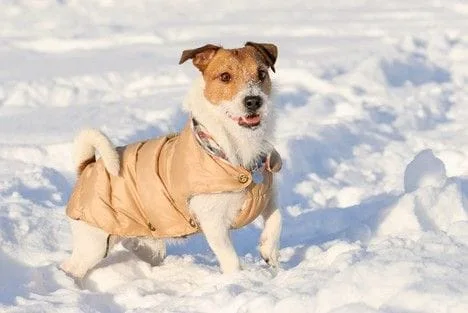Although dogs are always stylish in their own fur coats, it’s still necessary for them to have additional protection in the harsh winter weather. In fact, winter outdoor gear is essential for all breeds, any time the temperature is below freezing and especially during freezing rain or snow.

All sizes of dogs need cold weather protection. Small and short-coated dogs lose body heat very quickly and need protection from low temperatures; and large and long-haired breeds will get hypothermic too when they outside for a long period of time in very cold and wet weather.
Sweaters and jackets provide an extra layer of protection against rain, wind and snow. For proper protection, chose the right style, size and material. For those dogs who are particularly sensitive to the cold, you should have several choices of outerwear available to select from and match the correct amount of warmth for the different types of winter weather.
Fit is critical. Whatever styles you choose, make sure that it fits properly. Dogs come in many shapes and sizes and no one style could possibly fit a dachshund and a mastiff. Here’s a checklist of items to consider:
- Measure Your Dog, (Usually a Two-Person Process). Using a paper tape measure, accurately measure and record your dog's chest girth, neck circumference and length from the base of the neck (where the neck meets the body) to the start of the tail. These measurements guide you to the right size from a garment’s label chart. If possible, bring your dog with you to the store and use this information to start looking in the right size category and try things on right there.
- Check the Fit Around the Neck. The neck opening should be snug but not too tight. The fit is best is when you can comfortably slip two fingersbetween the garment and your dog's neck. This fit prevents cold from getting in while ensuring the item is not too tight to hinder your dog’s breathing.
- Assess the Chest Girth. The sweater or jacket must fit well around your dog's chest. It must be snug but not constricting. Your dog must be able to move his front legs freely without any discomfort or chafing.
- Evaluate the Length. The sweater should cover your dog's back from the base of the neck to the start of the tail without extending beyond it. It should not hinder your dog's ability to pee or poo.
- Look for Proper Leg and Private Part Openings. Check that the leg openings are appropriately sized and positioned; they should not cause chafing or restrict movement. Ensure the dog's legs can move freely. Again, make sure that your dog can urinate and defecate without the outerwear interfering.
- Observe Your Dog's Behavior When They Try on the Coat. Pay attention to your dog's body language and behavior while putting on, taking off and wearing the coat or sweater. If your dog seems uncomfortable, struggles to move, or constantly tries to remove the sweater, it probably doesn’t fit properly and you should choose something else. If your dog resents or resists having a sweater pulled over his head, choose a style that lays over his back and then fastens either underneath the chest or along the top.
- Check for Any Bunching or Sagging. The sweater or jacket should fit smoothly without bunching or sagging. Extra fabric can be uncomfortable and potentially lead to chafing, or tripping accidents.
- Ensure Easy Removal. Your dog should be able to easily step in and out of the sweater without struggling. If it's too difficult or your dog objects to it being put on or taken off, it may not be the right size or style.
- Make Sure the Leash Attaches Securely to the Collar or Harness While the Outer Wear is On the Dog. Make sure you have a proper opening to attach the leash to your dog’s collar or harness; some very nice coats and sweaters don’t provide for an opening to attach a leash to the collar. If the collar or harness goes over the outerwear you will likely need a larger harness. It is important you are certain in any case that the harness and collar are fit appropriately when the outerwear is on and that your dog cannot get free of the collar or harness.
- Choose the Right Material. Choose materials that are easy to clean, like polyester or acrylic. Confirm that outer layers on insulated coats are waterproof if rain or snow are anticipated; wool is not waterproof and can shrink after getting wet. As to warmth, I like insulations that contain polar fleece—a soft-napped and highly insulating fabric made from polyester. The fleece is non-absorbent and dries quickly.
- Allow your pet to get used to the outerwear at home first If you are having trouble getting the coat on, start by just showing it to your dog and offering a favorite treat to reward their attention and then for wearing it. Continue daily exercises of putting on the coat and rewarding your dog for wearing it for a few minutes before going outside for a walk.
- Check Size Periodically. As your puppy grows or if your dog has gained or lost some weight, recheck the fit periodically to ensure it remains suitable. And of course, check for new attractive styles. This is after all New York City, the fashion capital of the world!
Even dressed for the weather, always pay attention to your dog when outside. Use common sense and go home if your dog looks uncomfortable in the cold weather even if he looks great in his new coat.
Dog feet get cold too. Look for an upcoming Pets and the City Note on how you can protect their paws in the winter.

